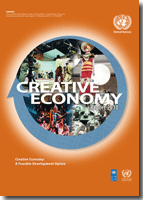By Elizabeth Murphy
The creative industries’ ability to innovate new economic opportunities continues to make headlines. Our colleagues at the National Creativity Network (NCN) offer inspiring examples of how the creative sector is driving innovation, job creation, and economic sustainability. Did you know that the State of Massachusetts employs a Creative Economy Director and that Vermont’s Department of Economic, Housing and Community Development has recently announced the establishment of the Office of the Creative Economy?
Over the past two decades, international governments (notably Ireland and the United Kingdom) have recognized the sizeable contribution the creative industries have made to their overall economies and have instituted policies and funding schemes designed to enhance this growing sector. In the United States, the terms “creative economy” and “creative industries” are beginning to take hold and are increasingly recognized as a powerful strategy for economic and community revitalization. As this field continues to develop, we are faced with the challenge of defining the creative industries, but nationally and internationally, this definition remains a moving target. Generally speaking, the sector has been described as a range of economic activities which are concerned with the generation or exploitation of knowledge, intellectual property and information. It is widely accepted that the activities which comprise the creative industries include architecture, design, arts, research & development, publishing, software, computer programming, scientific research, film, tv and radio. However, definitions are, by nature, limiting, and if there’s one thing we’re learning, it’s that the creative industries have an inherent capability to expand in unforeseen and innovative ways.
Recently, we have been invited to serve on the newly-established Creative Economy Coalition – a creative industries working group of the National Creativity Network. We join other thought-leaders around the country dedicated to: linking the creative industries to commerce, education, science, technology, and government; to advocating for the creative industries as an economic stimulus that grows jobs; and to stimulating innovation and imagination throughout our communities.
We are also interested in defining metrics for measuring the impact of the creative economy throughout the nation. Last week, members of the Creative Economy Coalition presented a very engaging NCN webinar on Growing the Creative Economy (Note: this webinar archive will be posted by the end of the week.) and you can also find previous webinars including one where New Jersey’s own Leo Vasquez from Arts Build Communities presented on the topic of Creative Placemaking.
While we all get our heads wrapped around the impact of the creative economy in our own state’s and communities, the United Nations Conference on Trade and Development (produced jointly with the United Nations Developing Programme) has published extensive research on the global creative economy. Their recent 2010 report provides evidence that the creative industries are among the most dynamic emerging sectors in world trade. The report defines the creative industries as “the crossroads of the arts, culture, business and technology…composing the cycle of creation, production, and distribution of goods and services that use intellectual property as their primary input.”
The rate of growth in world trade of creative goods rose from $7.8 billion in 2002 to $21 billion in 2008 (a growth rate of 14%). And despite the decline in the world economy brought about by the Great Recession, the creative industries have remained relatively robust. The report states, “The emerging creative economy has become a leading component of economic growth, employment, trade and innovation, and social cohesion in most advanced economies…It also shows that the interface among creativity, culture, economics and technology, as expressed in the ability to create and circulate intellectual capital, has the potential to generate income, jobs and export earnings while at the same time contributing to social inclusion, cultural diversity and human development.”
At Creative New Jersey, we are working to bridge the gap between our sectors, fostering connections between commerce, education, culture, government and philanthropy, in order to drive innovation and revitalize our state. We are currently developing a series of Community Creativity Convenings which will bring cross-sector leaders together to explore how creativity and innovation can transform their communities. We are working with a wide variety of partners in Essex, Monmouth, Mercer, Morris and Camden counties which include urban regeneration nonprofits and economic development councils, county arts councils and arts organizations, universities and educational associations, mayoral associations, sustainability and environmental nonprofits, and philanthropic leaders.
Together, county by county, we will begin to transform our Garden State through spirited, ground-breaking discussions which challenge the status-quo and encourage new partnerships and strategies that have the potential for reinvigorating the local and statewide economy while strengthening the fabric of our communities. In the coming weeks, we will announce the schedule for the upcoming Community Creativity Convenings, and we will keep you informed as new convenings are announced.
The power of this transformation lies in the infinite capabilities of each and every New Jerseyan as we meet at the intersection of our sectors. So, join us at the crossroads, and let us know if you are interested in working with Creative New Jersey in hosting a Community Creativity Convening in your town.
Inquiries regarding joining the Creative New Jersey movement and/or hosting a Community Creativity Convening should be sent to Elizabeth Murphy at emurphy[at]creativenj[dot]org.
Creative New Jersey’s leaders and partners are regular contributors to the Dodge blog

